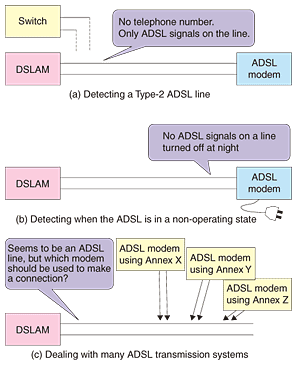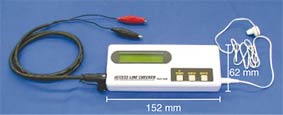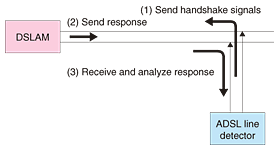 |
|||||||
|
|
|||||||
|
Special Feature on Technical Solutions to Real-world Problems Vol. 5, No. 7, pp. 11–13, July 2007. https://doi.org/10.53829/ntr200707sf3 ADSL Line DetectorAbstractA simple and handy maintenance tool has been developed for use in DSL-related construction work. Unlike existing commercial ADSL (asymmetric digital subscriber line) line-checking tools, this tool can identify an ADSL line even when the modem has been turned off or physically removed, regardless of the type of ADSL transmission system being used. It is expected to be useful in line switching and other operations.
1. BackgroundWhile general customers use ADSL (asymmetric digital subscriber line) as a high-speed access line to the Internet, the corporate world uses many ADSL lines as inexpensive access lines to a leased line system. In the latter case, these ADSL lines are often Type-2 dedicated ones that do not share the line with a telephone. Because problems that arise during the course of line construction can be highly disruptive to corporate activities, it is essential that such problems be prevented from happening in the first place. Nevertheless, there have been cases in which commercially available ADSL line-checking tools from various makers have not checked lines correctly. 2. Points of concern in line construction2.1 Targeted line typesIn line construction (line installation, removal, and switching), the types of lines targeted for work are not limited to ADSL. The following types may be encountered. (1) Subscriber telephone lines (2) ISDN (integrated services digital network) lines (including digital access to I-interface leased lines) (3) Type-1 ADSL lines (with shared telephone service) (4) Type-2 ADSL lines (dedicated to ADSL) (5) Other leased lines Before line construction work is begun, the presence of any of these lines should be checked in a database. Various types of checking tools may also be used to raise the accuracy of on-site line identification. It must be kept in mind that inaccurate detection of line signals can result in flawed line-type judgment and erroneous disconnection. It is therefore essential that signals produced by the above types of lines be detected correctly so that on-site line checking can be performed using tools. 2.2 Characteristics of ADSL lines(1) ADSL comes in two types: Type 1 shares the line with a subscriber telephone while Type 2 does not. A Type-1 line can be identified from the telephone number, but this cannot be done for a Type-2 line because no telephone number is assigned to the line (Fig. 1(a)).
(2) In the case of a Type-2 line, the ADSL modem's power supply may be turned off at night or the modem may even be disconnected from the line, depending on how the customer uses it. In such a state, there are no signals on the line, which increases the chance of mistakenly identifying the line as an unused one (Fig. 1(b)). (3) Many types of transmission systems are used for ADSL lines (such as G.992.1Annex C, G.992.1Annex I, double-spectrum ADSL, and quad-spectrum ADSL). This means that several different kinds of ADSL modems must be prepared to detect an ADSL line (Fig. 1(c)). 3. Detector functions and features3.1 Overview of functionsTaking into account the above types of targeted lines and ADSL line characteristics and giving due consideration to ease of use, NTT developed a line-checking tool with importance attached to the following functions (Fig. 2).
(1) Detects an ADSL line even if the line is in a non-operating state (for both Type-1 and Type-2 lines) (2) Detects the ADSL carrier while the line is in an operating state (for both Type-1 and Type-2 lines) (3) Determines whether a subscriber telephone line is being used (4) Determines the state (up or down) of layer 1 of an ISDN line (checks for the presence of ping-pong transmission signals) 3.2 FeaturesLine-checking tools incorporating functions (2) to (4) have previously been put on the market by various companies. However, if the ADSL line is in a non-operating state (e.g., the modem's power supply has been turned off or the modem itself has been disconnected from the line), it is not possible to determine that the line is actually an ADSL line without preparing many modems—one corresponding to each of the various types of ADSL lines—and linking up with the modem later. NTT's new detector uses handshaking procedures [1] before linking up with an ADSL modem so that an immediate judgment can be made as to whether the target line is ADSL or not, regardless of the ADSL transmission system and even if no ADSL signals are present on the line. 3.3 Example of ADSL line detectionThe method of detecting an ADSL line when the line is in a non-operating state is shown in Fig. 3.
(1) The detector sends handshake signals to the digital subscriber line access multiplexer (DSLAM)*. (2) The DSLAM returns a response to the received handshake signals. (3) The detector decides whether or not the line is ADSL based on the response received from the DSLAM and displays the result on a liquid-crystal screen.
4. Authentication system platform technologyGiven the importance of determining what types of lines are in use—regardless of whether they are ADSL—when workers set out to perform line construction work, the ADSL line detector presented here raises the accuracy of on-site line checking. The Technical Assistance & Support Center of NTT East performs technical problem solving on-site at the front line. It will continue its efforts to improve service quality through the development of maintenance support tools. References
|
|||||||










